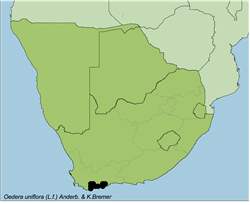Names and synonyms
Oedera uniflora (L.f.) Anderberg & Bremer=Relhania uniflora (L.f.) Druce =Athanasia uniflora Linne f. =Relhania cuneata L'H�rit., nom. superfl.=Eclopes cuneata (L'Herit.) Lessing =Relhania virgata L'Heritier =Relhania cuneata L'H�rit. var. virgata (L'H�rit.) S. Moore =Eclopes decussata auct. (excl. Relhania decussata L'Herit.)
Type
Burchell 6763, Riversdale dist., Hills near Zoetmelks River, 1814-11-21 (K)
Common names
Vierkant gombos, Kalksteenperdekaroo
Derivation of names
Oedera = after George Christian Oeder (1728-1791), professor of Botany in Copenhagen, author of Flora Danica uniflorus = single-flowered
Diagnostic characters
Plants very stickyLeaves 4-rankedLeaves with a very distinct absision line at the baseLeaves apically recurved or hookedCapitula solitary, terminal
Description
Rounded, much branched twiggy shrublet to 0.50(-0.7) m tall. Stems glabrous or sparsely tomentose, densely leafy, bare in lower parts and marked with leaf-scars. Leaves in 4 ranks, 3-8 x 1-2 mm, oblong and channelled, overlapping, sessile, with a clear line of absision at the attachment with the stem, the tips curved back or hooked. Capitula solitary, sessile, terminal, radiate, 10 mm in diameter. Involucre cup-shaped, 3-7 mm wide. Involucral bracts 20-30, outer ovate, inner gradually longer and oblong, with a spreading apical limb. Receptacle flat-convex, paleate. Paleae canaliculate, linear or sometimes narrowly spatulate, 4.5-6 mm long, 0.4-1 mm wide, dorsally gland-dotted, acute. Ray florets 6-14, tube 1.8-2.7 mm long, glandular, lamina elliptic, 3.5-5 x 1.3-2 mm, 4-veined. Disc florets 20-65, perfect. Cypselas flattened or somewhat tetraquetrous, narrowly oblong, 1.8-2.5(-3.0) x 0.5-0.7(-0.8) mm, glabrous or pilose on lateral ribs. Pappus crownlike, of � connate scales, up to 1.6 mm long.
Flowering time
Mainly from October / November to January.
Distribution
Known from various localities from Saldanha Bay, Worcester, Bredasdorp, Swellendam and Riversdale to Albertinia.Known from 25 specimens.
Habitat
In sandy soils or limestone outcrops, coastal dunes and limestone hills, dry steep shale hill, sandy or clayey soils
Notes
O. uniflora is usually readily recognized by its decussate, apically hooked leaves and solitary capitula. It is possibly related to O. silicicola, but has much wider capitula with paleate receptacles.
References
ANDERBERG, A.A. & BREMER, K. 1991. Parsimony analysis and cladistic reclassification of the Relhania generic group (Asteraceae - Gnaphalieae). Annals of the Missouri Botanical Garden 78: 1061-1072.BREMER, K. 1976. The genus Relhania (Compositae). Opera Botanica 40.GOLDBLATT, P. & MANNING, J.C. 2000. Cape Plants. A conspectus of the Cape flora of South Africa. Strelitzia 9. SANBI.HILLIARD, O.M. 1977. Compositae in Natal. University of Natal Press.HARVEY. 1865. Compositae in: W.H. Harvey & O.W. Sonder. Flora Capensis 3 (ed. 1). Hodges & Smith, Dublin.KESTING, D. & CLARKE, H. 2008. Botanical names, what they mean. Wild Flowers of the Cape Peninsula, 3rd revised edition. Friends of Silvermine.MANNING. J. 2007. Field Guide to Fynbos. Struik Publishers.MANNING, J. & GOLDBLATT, P. 1996. West Coast. South African Wild Flower Guide 7. Botanical Society of South Africa.PHILLIPS.1940. The Flowering Plants of South Africa 20: t. 786SMITH, C. A. 1927. Four interesting species of Compositae. Bothalia 2: 360-365.
